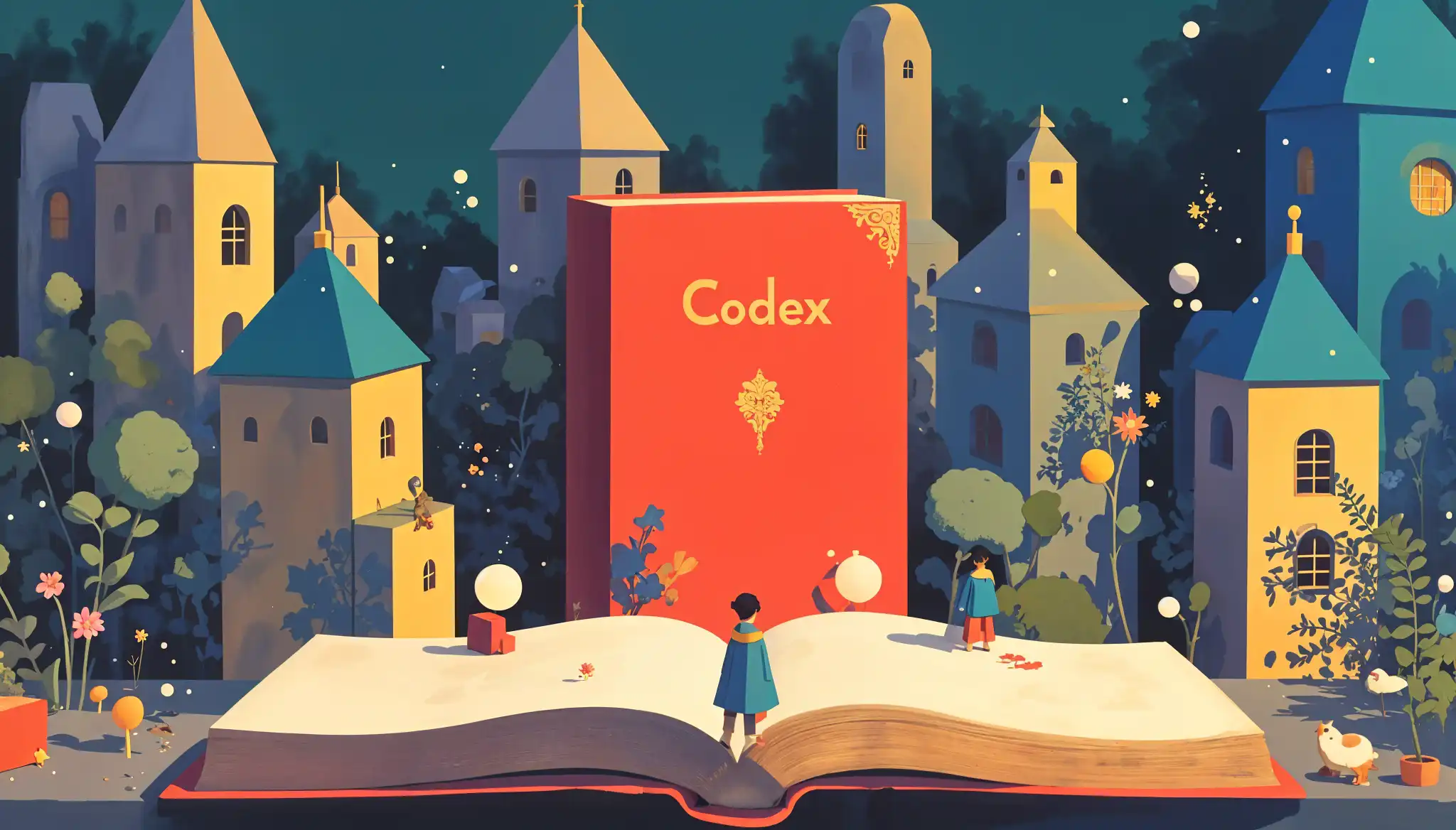
- Level:
- Advanced
- Lessons:
- 10 Lessons
Dual Nature Characters
Master the art of tracking characters with dual identities or personalities without confusing your AI assistant.
- Reading Time
- approx. 5 min
Whilst most Codex entries for characters are straight forward, there may come a time where you are unsure about how to structure them. What if you are writing about a Superman-like person, who has an alter-ego? Or a transformation story inspired by Jekyll and Hyde? Or your character has multiple personalities, and you would like a way to document them sensitively, but separate from the primary persona.
The various facets of your character might have distinct voices, motivations, appearances, and relationships with other characters. Without clear documentation, these differences can blur together, leading to inconsistent characterization.
For AI assistance, being clear is especially crucial. AI models can struggle with understanding that two seemingly different characters are actually the same person in different states, leading to outputs that mix traits inappropriately or miss the significance of the duality.
Or, even worse, the two identities interact with each other!
When should I use this?
- Your character has a genuine split personality or a transformation
- Your character maintains a secret identity (superhero/civilian, spy with covers)
- Your character undergoes a significant transformation that essentially creates a new person, and you don’t want to replace the old codex entry
- You need to track which characters know about which identity
How
We have several options for documenting these complex characters, and you can choose the one that best fits your story’s needs. Depending on if you’re hand-writing, or using AI, you may find that different methods work for you.
Option 1: Single Entry with Sections
The most managable option for the human-writer, however some smaller models may not understand all of the nuances.
Create one character Codex entry with the character’s primary or “true” name
Add aliases for any other identities/names any facet of the character is known by
In the description, clearly mark sections for each personality/identity
Use custom details to separate traits for each identity, or subheadings within the main description.
Include a note about the nature of the transformation/switch between identities
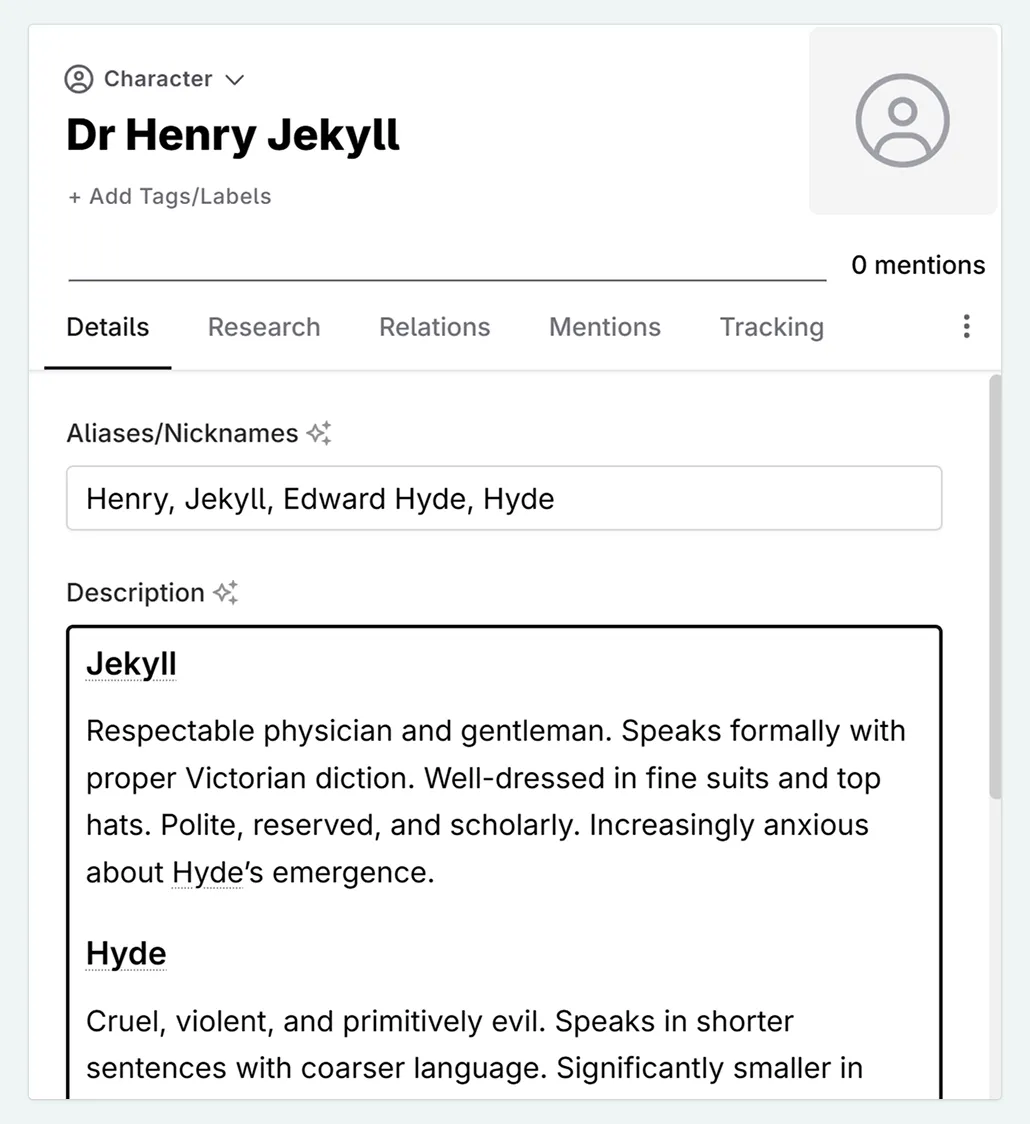
Best for: Characters whose identities are known to be connected or where the duality is straightforward.
I recommend including a note about how subtle you want these transformations are. You may need to specify in your scene and/or beat which persona is present, if the AI is getting it wrong.
Option 2: Linked, but Separate Entries
This option is good for if you find that you have to ‘hand-hold’ the AI models in the scene beats.
Create separate character Codex entries for each identity
In each entry’s description, explicitly note the connection to the other identity, and when it should/shouldn’t be brought up (either in the description, or as a dedicated detail)
Use references to make both entries appear when either name is mentioned
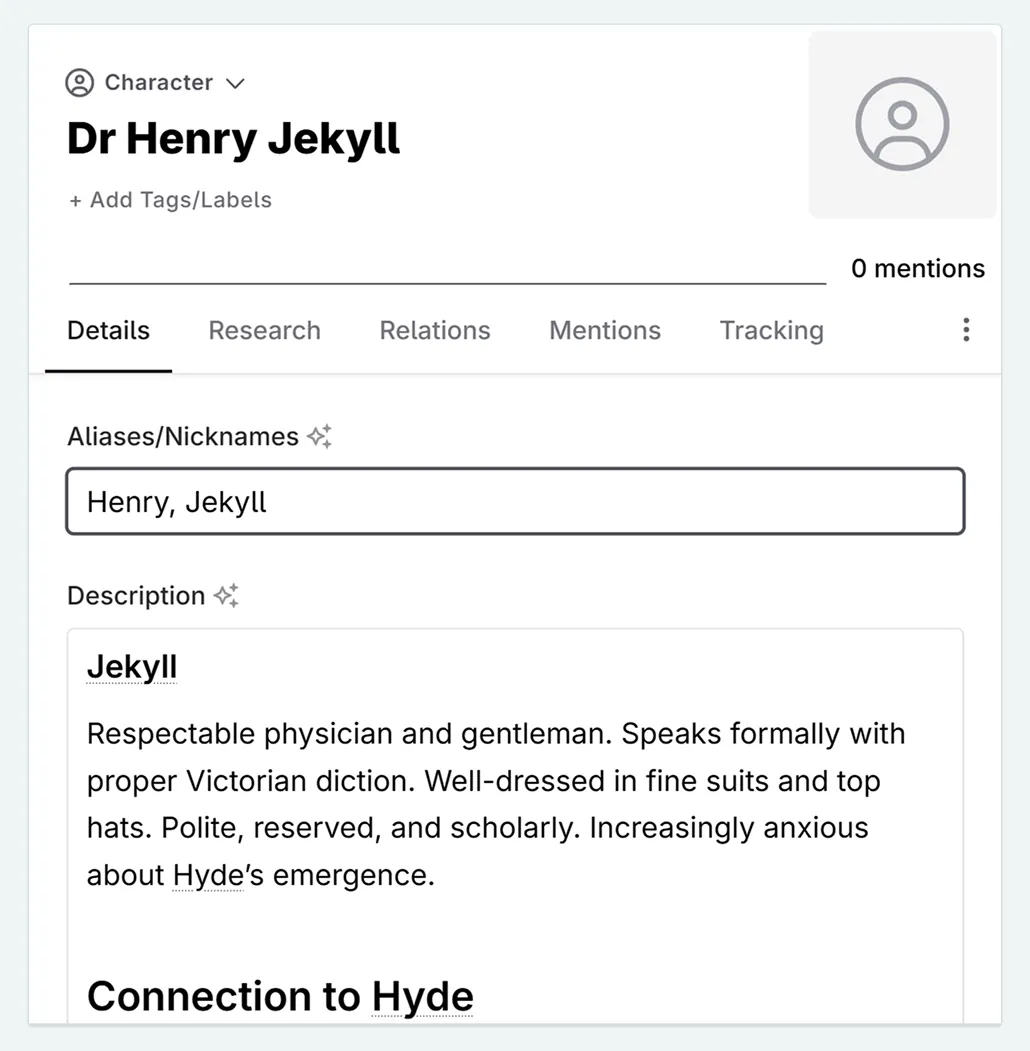
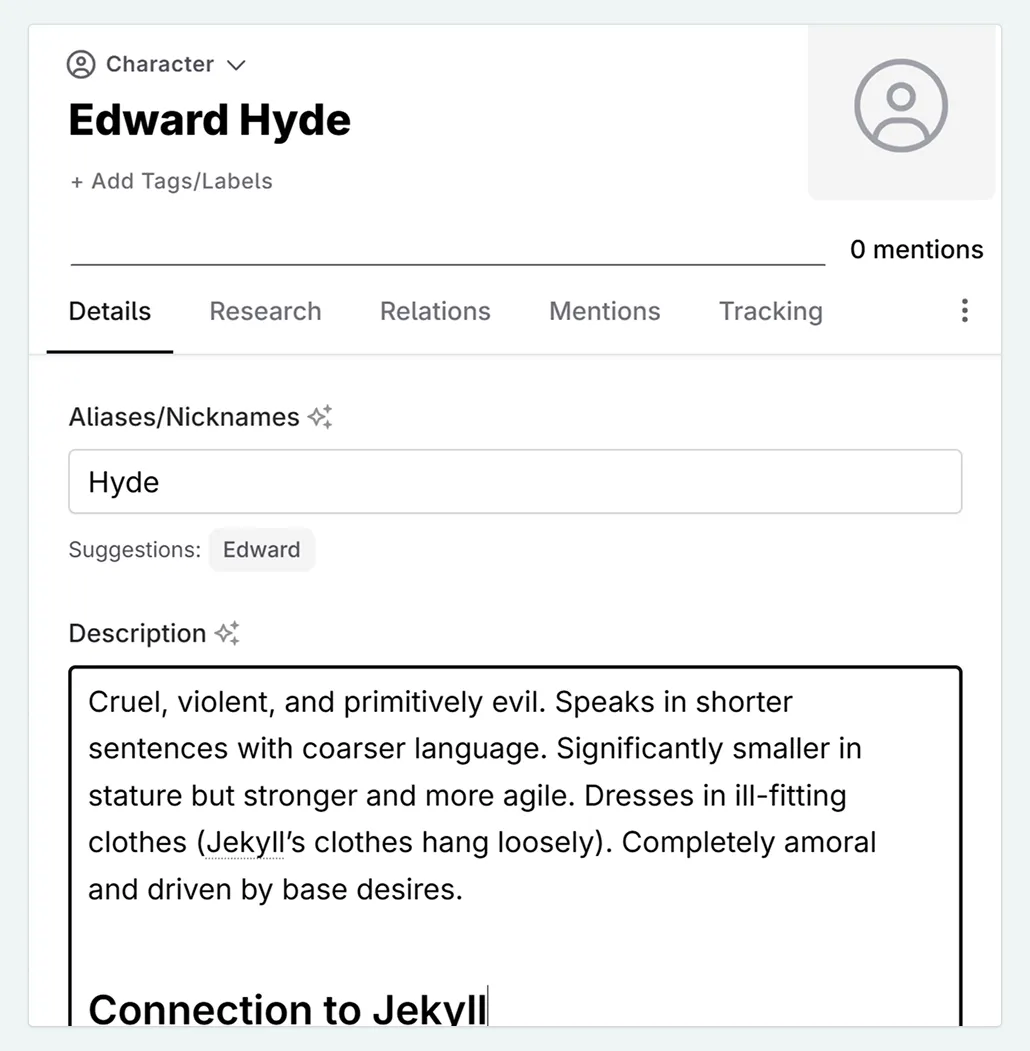
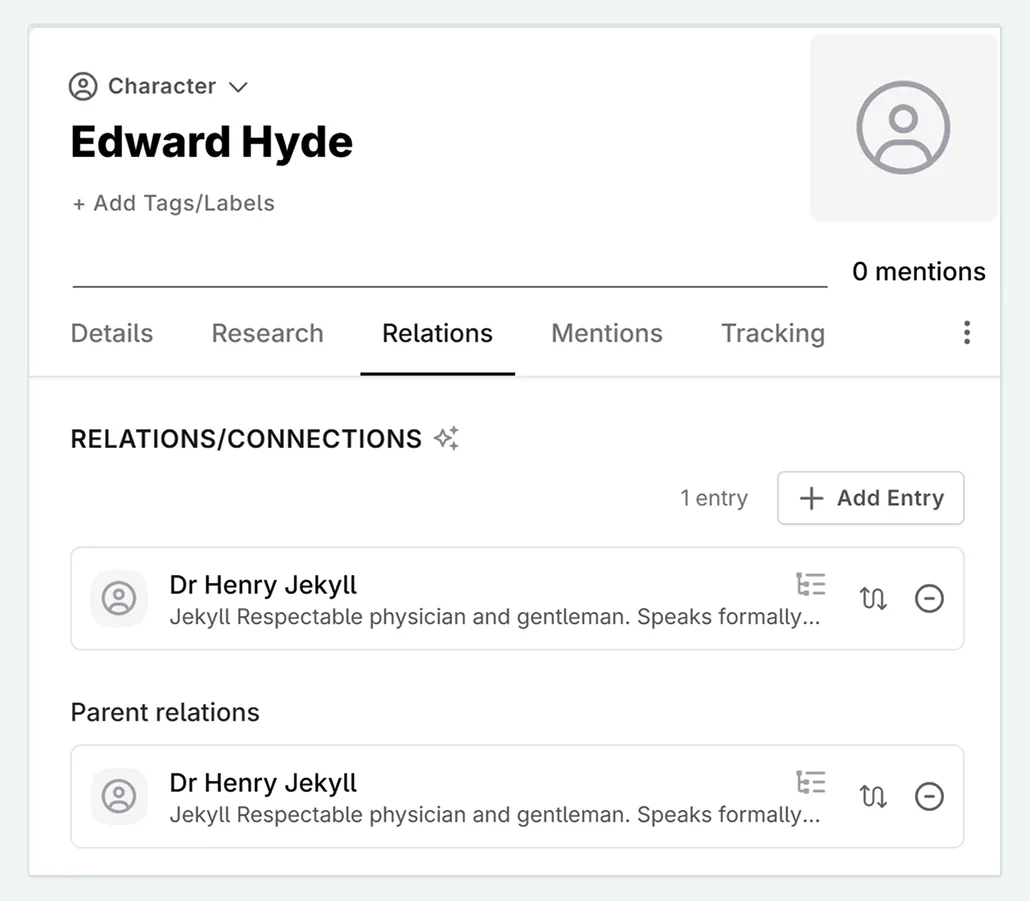
Best for: Characters whose identities are meant to seem separate to readers for part of the story, or where the personalities are dramatically different. Also great for superheroes.
Option 3: Single Entry with Progression Markers
Option 1, but on steroids.
Create one primary character Codex entry that contains information of both personas
Use Codex progressions to mark points where the character switches identities
In these progressions, update relevant details like:
- Voice patterns
- Behavioural traits
- Physical appearance changes
- Knowledge differences
 You may want to play around with when you want to use additions or replacements to see which fits your story better.
You may want to play around with when you want to use additions or replacements to see which fits your story better.
Best for: Characters whose transformations occur at specific points in your narrative and where tracking the timing of changes is important.
Case study
Let’s look how we might create a Codex entry for Dr. Jekyll/Mr. Hyde from Robert Louis Stevenson’s classic novella, using the single entry approach.
Jekyll
Respectable physician and gentleman. Speaks formally with proper Victorian diction. Well-dressed in fine suits and top hats. Polite, reserved, and scholarly. Increasingly anxious about Hyde’s emergence.
Hyde
Cruel, violent, and primitively evil. Speaks in shorter sentences with coarser language. Significantly smaller in stature but stronger and more agile. Dresses in ill-fitting clothes (Jekyll’s clothes hang loosely). Completely amoral and driven by base desires.
Triggers for Transformation
- Initially: Drinking the potion
- Later: Involuntary transformations during sleep
- Final stages: Transformations occur with increasing frequency without warning
Physical Indicators of Transformation
- Jekyll to Hyde: Painful transformation, reduction in height, face becomes twisted and primitive
- Hyde to Jekyll: Exhaustion following transformation, disorientation
Knowledge Differences
- Jekyll: Aware of Hyde’s actions but cannot control them
- Hyde: Full awareness of Jekyll’s life and thoughts
Who Knows the Truth
- Dr. Lanyon: Witnessed a transformation, dies from the shock
- Mr. Utterson: Discovers the truth through Jekyll’s letter after his death
- Poole (butler): Suspects something is wrong but doesn’t know the full truth
Potential Tweaks
Now, it may be that as we write, we notice that the triggers for transformation get tangled up. At this point, we might decide we need to utilise method 3, and add some progress additions. Or, we find that the characters that shouldn’t know about the transformation do. In that case, we may want to go to the secondary character’s Codex entry and add in additional notes regarding their knowledge.
Troubleshooting
Characters transform at inappropriate moments
During writing, your dual-nature character suddenly shifts identity without proper narrative setup, or fails to transform when they should based on established triggers.
Cause: Vague or missing documentation about specific transformation triggers and conditions.
Solution:
Create a dedicated “Transformation Triggers” section in your Codex entry that clearly outlines:
- Exact circumstances that cause transformations
- Any progression in how transformations work throughout the story
- What factors prevent change
Mention in your beats if a transformation occurs or not. Don’t let the AI guess if you know in advance if a shift should occur. Mention your character by name throughout, using the correct aliases for each part of the scene.
Character knowledge blurs between identities
e.g. Jekyll recalls events that happened only to Hyde when he shouldn’t have this memory.
Cause: Insufficient clarity about what each identity knows about the other’s experiences.
Solution: Include a specific “Memory/Knowledge” section that states:
- What each identity remembers about the other’s actions
- How this memory relationship might evolve
- Key information that should remain exclusively with one identity
You can use codex progressions for this, or document the information on the secondary character’s Codex.
Secondary characters respond inconsistently
A character who shouldn’t know about the dual nature addresses Hyde as Jekyll, or characters react with surprise repeatedly to a transformation they’ve already witnessed.
Cause: Missing documentation about who knows the secret and when they discovered it.
Solution: Add additional information to the Codex of the secondary character, to state:
- Which identities they know of
- How they typically respond to each identity
Voice and dialogue inconsistencies
The character’s distinct speech patterns blend together, making identities less distinct.
Cause: There is not enough detail on how the two voices differ.
Solution: Develop separate voice guides for each identity, specifying:
- Vocabulary preferences
- Sentence structure and length
- Speech quirks and verbal tics
- Emotional expression patterns
- Example dialogue that exemplifies their distinct voice
Or use a voice sheet to really direct how the characters should speak.
This lesson was taught by:
Kate Robinson
Based in the UK, Kate has been writing since she was young, driven by a burning need to get the vivid tales in her head down on paper… or the computer screen.